
Anagallis arvensis, commonly known as the scarlet pimpernel, red pimpernel, red chickweed, poor man's barometer, poor man's weather-glass, shepherd's weather glass or shepherd's clock, is a species of low-growing annual plant with brightly coloured flowers, most often scarlet but also bright blue and sometimes pink. The native range of the species is Europe and Western Asia and North Africa. The species has been distributed widely by humans, either deliberately as an ornamental flower or accidentally. A. arvensis is now naturalised almost worldwide, with a range that encompasses the Americas, Central and East Asia, the Indian Subcontinent, Malesia, the Pacific Islands, Australasia and Southern Africa.
The Peace of Callias is a purported peace treaty established around 449 BC between the Delian League and Persia, ending the Greco-Persian Wars. The peace was agreed as the first compromise treaty between Achaemenid Persia and a Greek city.
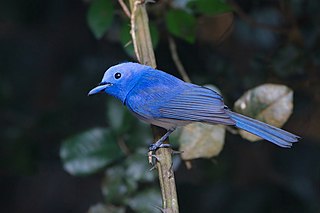
The black-naped monarch or black-naped blue flycatcher is a slim and agile passerine bird belonging to the family of monarch flycatchers found in southern and south-eastern Asia. They are sexually dimorphic, with the male having a distinctive black patch on the back of the head and a narrow black half collar ("necklace"), while the female is duller with olive brown wings and lacking the black markings on the head. They have a call that is similar to that of the Asian paradise flycatcher, and in tropical forest habitats, pairs may join mixed-species foraging flocks. Populations differ slightly in plumage colour and sizes.
Callias was an Ancient Greek statesman, soldier and diplomat, active in 5th century BC. He is commonly known as Callias II to distinguish him from his grandfather, Callias I, and from his grandson, Callias III, who apparently squandered the family's fortune.
Callias was an ancient Athenian aristocrat and political figure. He was the son of Hipponicus and an unnamed woman, an Alcmaeonid and the third member of one of the most distinguished Athenian families to bear the name of Callias. He was regarded as infamous for his extravagance and profligacy.
Callias of Chalcis, son of Mnesarchus, together with his brother Taurosthenes, succeeded his father as tyrants of Chalcis. Callias formed an alliance with Philip of Macedon against Plutarch, tyrant of Eretria, with the view of extending his authority over the whole of Euboea, a design which, according to Aeschines, he disguised as a plan for uniting in one league the states of the island and establishing a general Euboean congress based at Chalcis.
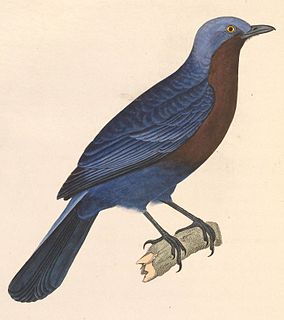
The Javan cochoa is a species of bird in the family Turdidae. It is endemic to Indonesia.

Hypothymis is a genus of birds in the family Monarchidae.
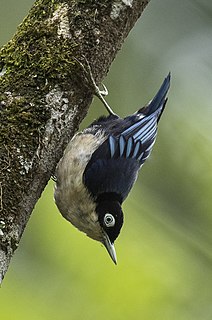
The blue nuthatch is a bird species in the family Sittidae, collectively known as nuthatches. It is a medium-sized nuthatch, measuring 13.5 cm (5.3 in) in length. The species, which lacks sexual dimorphism, has dramatic coloration unlike any other member of its genus. Its head is black or blackish-blue dark blue upper parts close to purple with azure feathers. The wings are edged with black. The throat and chest are white or a washed buff color, contrasting with the upper and the belly of a very dark blue; the feathers are generally clear, blue-gray or purplish.
Callias, sometimes called by the nickname Schoenion (Σχοινίων), was a poet of the Old Comedy, not to be confused with the three Athenian aristocrats named Callias, the last of which, Callias III, appears in Plato's Protagoras.
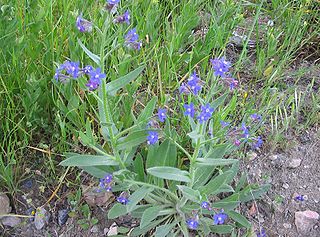
Anchusa azurea is a species of flowering plant in the family Boraginaceae, known by the common names garden anchusa and Italian bugloss. It is a bristly perennial which may reach 1.5 meters tall and 60 centimeters wide. It has straight lance-shaped leaves and petite tubular flowers about 15 millimeters across with five bright violet-blue. These flowers, which typically appear May-July, are edible and attract bees. This species is native to Europe and western Asia and eastern Maghreb but is well-known elsewhere as a noxious weed. In Crete it is called agoglossos and the locals eat the tender stems boiled, steamed or fried.
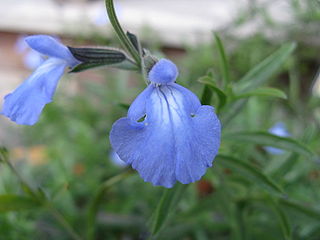
Salvia azurea, the azure blue sage, azure sage, blue sage or prairie sage, is a herbaceous perennial in the genus Salvia that is native to Central and Eastern North America.
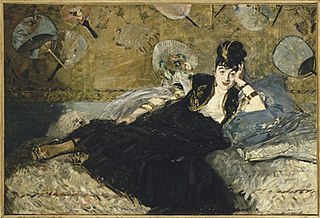
Anne-Marie Gaillard, known as Nina de Villard de Callias, Nina de Callias or Nina de Villard, was a French composer, pianist, writer, and salon hostess.

Erebia callias, the Colorado alpine, is a member of the Satyridae subfamily of the Nymphalidae butterflies. It is found in alpine areas of Wyoming and Colorado in the U.S. Rocky Mountains as well as various mountain ranges in eastern Asia.

Pontederia azurea is a water hyacinth from the Americas, sometimes known as anchored water hyacinth. It is the type species of Pontederia subg. Eichhornia, which was previously recognized as part of the polyphyletic genus Eichhornia. It is of some interest as an aquarium plant.

Opuntia azurea, the purple prickly pear or coyotillo, is a long-spined prickly pear that is native to a variety of habitats, including desert, mountain grasslands, and slopes in the Big Bend region of Texas and in the states of Coahuila, Chihuahua, Durango, and Zacatecas in Mexico. It flowers from March to May, with bright yellow flowers with red centres which produce red/purple fruits. Opuntia azurea forms sprawling clusters, two to three feet high.
Calliini is a tribe of longhorn beetles of the subfamily Lamiinae.
Callia is a genus of longhorn beetles of the subfamily Lamiinae.

Nancy Fish Barnum Callias D'Orengiani, Baroness was an English socialite who was the second wife of P. T. Barnum. The daughter of a successful English cotton mill owner, she started a relationship with Barnum, who was 40 years her senior. After the death of Barnum's first wife in 1873, they married the following year in both London and New York City. After his death in 1891, Barnum left Fish a large annuity, making her a wealthy widow.
Morelia azurea is a species of snake. Commonly known as green pythons, these arboreal pythons were previously included in the Morelia viridis complex.











